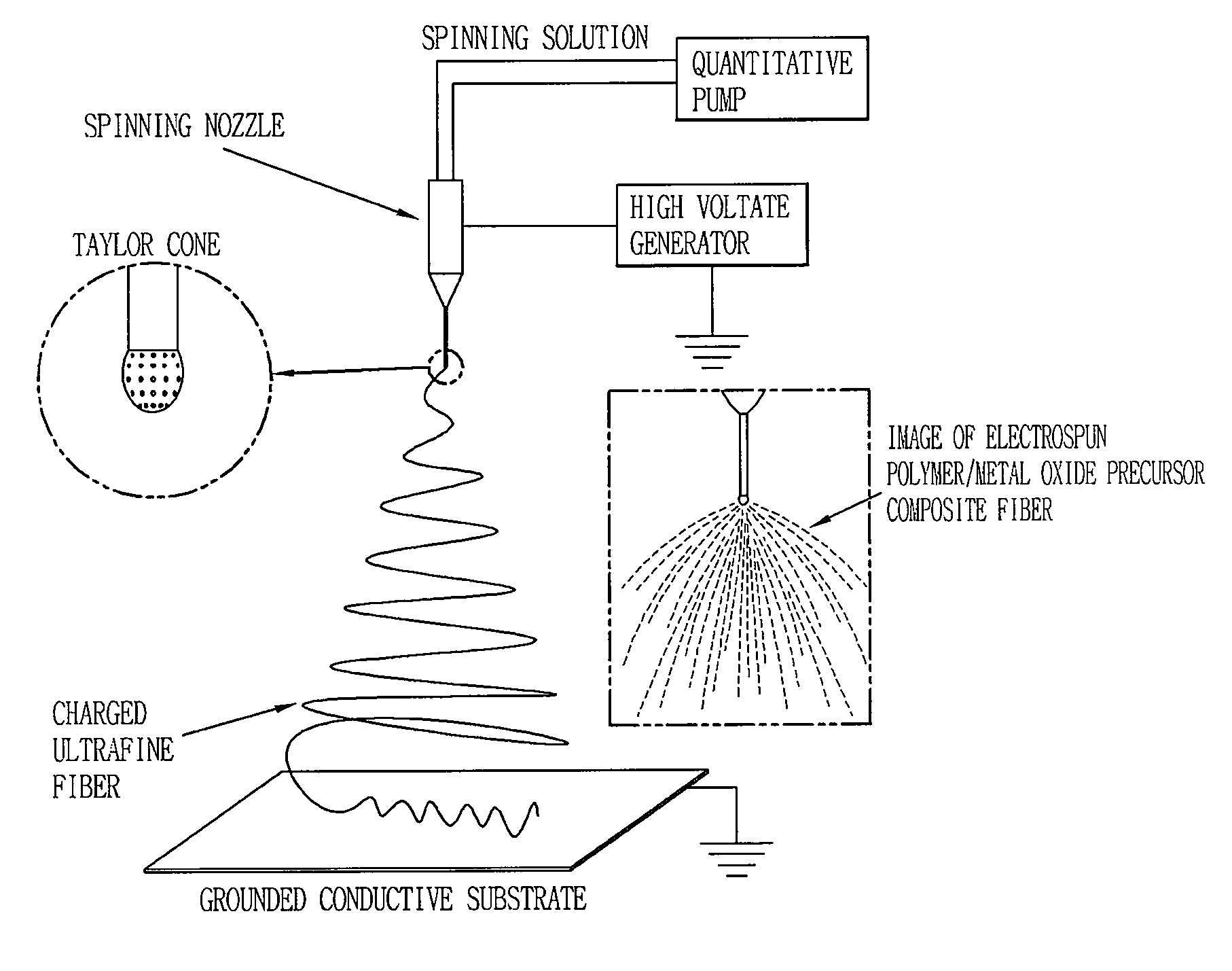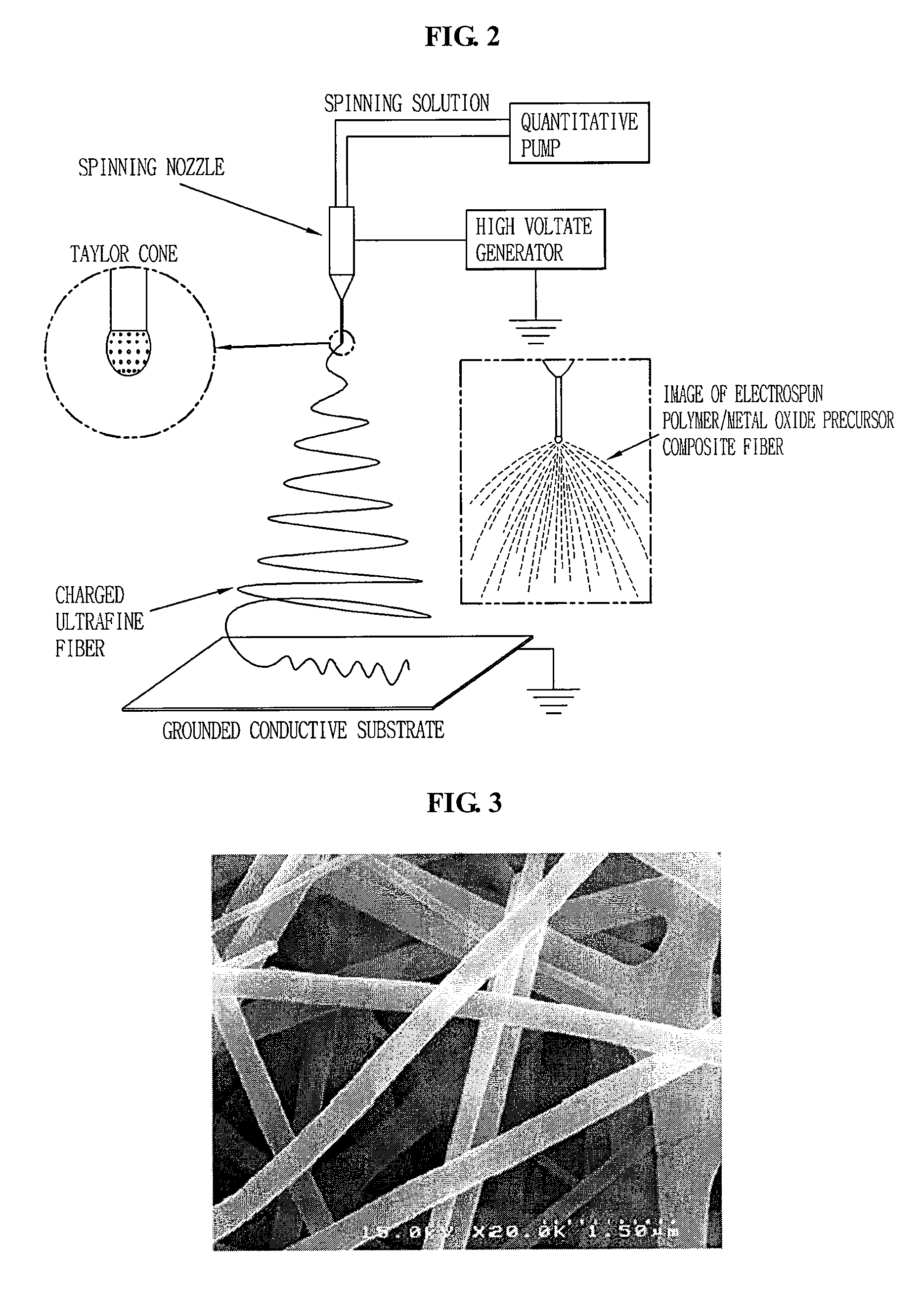Anode for secondary battery having negative active material with nano-fiber network structure and secondary battery using the same, and fabrication method of negative active material for secondary battery
- Summary
- Abstract
- Description
- Claims
- Application Information
AI Technical Summary
Benefits of technology
Problems solved by technology
Method used
Image
Examples
example 1
Fabrication of an SnO2 Nano-Fiber Network Structure Through Thermocompression and Post-Heating Treatment of an SnO2-Polyvinyl Acetate Composite Fiber Layer
[0067]A polymer solution obtained by dissolving 2.4 g of polyvinyl acetate (Mw: 1,000,000) in 15 ml of dimethylformamide for one day was mixed with a solution obtained by dissolving 6 g of tin acetate in 15 ml of dimethylformamide (DMF). Here, the solution was transparent and slightly yellowish. Since tin acetate is easily dissolved in DMF, a reaction occurred well without additionally using acetic acid for catalysis.
[0068]The transparent precursor in which the reaction had occurred was transferred into a syringe and mounted on the electrospinning device. Then, a voltage was applied between the tip provided at the end of the syringe and a collector to obtain an SnO2-polyvinylacetate composite fiber layer (see FIG. 3). In this case, the voltage was 12 kv, the flow rate was 30 μl / min, the total discharge amount was 500 to 5,000 μl, ...
example 2
Fabrication of an Fe2O3 Nano-Fiber Network Through Thermocompression and Post-Heating Treatment of an Fe2O3-Polyvinyl Alcohol Composite Fiber Layer
[0076]2.5 g of polyvinyl alcohol (PVA, Mw: 88,000) was dissolved by stirring into 20 g of DI water for one day with heat. The PVA solution was mixed with a solution obtained by dissolving 5 g of anhydrous FeCl3 in 15 g of DI water. A transparent deep green solution could be obtained after stirring for several minutes. Then, 2 g of acetic acid and 0.05 g of Cetyltrimethylammonium bromide (CTAB) were added therein and stirred for several minutes. Here, CTAB serves as an additive for facilitating electrospinning by controlling electric charge characteristics of the metal oxide precursor.
[0077]After such prepared solution was transferred into a syringe and electrospun, a light green PVA-FeCl3 organic / inorganic composite fiber could be obtained (applied voltage: 14 kV, flow rate: 10 μl / min, amount of fabricated fiber: 500 μl, substrate: SUS, d...
example 3
Fabrication of a TiO2 Nano-Fiber Network Through Thermocompression and Post-Heating Treatment of a TiO2-Polyvinyl Acetate Composite Fiber Layer
[0083]6 g of titanium propoxide (Titanium(IV) propoxide) was added to be stirred into a polymer solution prepared by dissolving 37.5 ml of a mixed solvent of dimethylformamide (DMF) into 3 g of polyvinyl acetate (Mw: 850,000). Then, 2.4 g of acetic acid was slowly added as a reaction catalyst.
[0084]The electrospinning was carried out by using the electrospinning device in FIG. 1. A stainless steel (SUS) substrate was used as a cathode, and the metal needle connected to the pump controlling the discharge speed was used as an anode. A voltage of 15 kV was applied between the two electrodes. The discharge speed of the spinning solution was controlled to 30 μg / min. The electrospinning was performed until the total discharge amount became 500-5,000 μl, thereby forming an ultrafine TiO2-polyvinyl acetate composite fiber layer on the stainless steel...
PUM
| Property | Measurement | Unit |
|---|---|---|
| Temperature | aaaaa | aaaaa |
| Size | aaaaa | aaaaa |
| Size | aaaaa | aaaaa |
Abstract
Description
Claims
Application Information
 Login to View More
Login to View More - R&D
- Intellectual Property
- Life Sciences
- Materials
- Tech Scout
- Unparalleled Data Quality
- Higher Quality Content
- 60% Fewer Hallucinations
Browse by: Latest US Patents, China's latest patents, Technical Efficacy Thesaurus, Application Domain, Technology Topic, Popular Technical Reports.
© 2025 PatSnap. All rights reserved.Legal|Privacy policy|Modern Slavery Act Transparency Statement|Sitemap|About US| Contact US: help@patsnap.com



